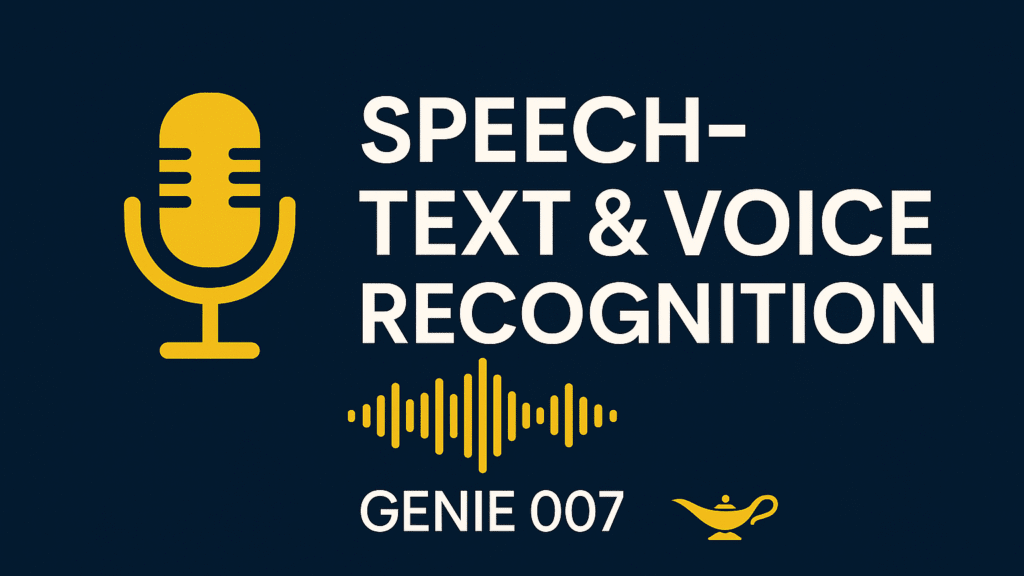Speech to text software is transforming business operations in 2025. Voice is the new UI. Speech-to-text (STT) and voice recognition are no longer niche they’re core to how businesses capture data, automate workflows, and deliver delightful, accessible experiences. This ultimate guide explains the tech, ROI, use cases, best tools, and a practical roadmap to deploy speech to text software with Genie007 at the core. Use this guide to plan deployments that boost productivity, compliance, and customer satisfaction while reducing cost-to-serve.
What Is Speech to Text Software and Voice Recognition?
Speech to text software converts spoken audio into written text. Voice recognition (speaker recognition) identifies who is speaking, while voice control interprets commands. Modern speech to text software systems combine automatic speech recognition (ASR), large language models (LLMs), diarization, punctuation, and summarization to output clean, structured transcripts and insights.
Key terms:
- ASR: Core model that maps audio to tokens/words
- VAD: Voice activity detection that trims silences/noise
- Diarization: “Who spoke when” segmentation
- NER & PII redaction: Entity extraction and privacy controls
- Custom vocabulary/boosting: Domain and product terms
- Post-processing: Auto punctuation, casing, formatting
In 2025, state-of-the-art models deliver near-human accuracy for clean, wideband audio, with dramatic improvements on accents, domain jargon, and noisy environments. Hybrid stacks combine real-time streaming for live use cases and batch processing for archival/transcription at scale.
Business Benefits and Case Studies
- Contact Centers: Reduce average handle time (AHT) 10–25% with live agent assist, auto-disposition, and QA scoring. Case: A UK insurance desk used Genie007 STT + summarization to cut wrap-up by 2.8 minutes per ticket.
- Sales: Auto-log call notes into CRM, extract next steps, and update opportunities. Case: A SaaS vendor saw 18% higher opportunity win rate with call insights pushed to HubSpot.
- Compliance & Risk: 100% call transcription with PII redaction and keyword alerts enables proactive QA, PCI/GDPR alignment, and audit trails.
- Operations: Voice-to-work order in field service, hands-free updates in manufacturing, and safety incident dictation reduce paperwork and errors.
- Marketing & Content: Turn webinars/podcasts into SEO-rich blogs, clips, and captions. Multi-language captions expand reach and accessibility.
- Healthcare: Clinical dictation accelerates documentation and improves patient encounter completeness (HIPAA-ready architecture required).
Why Genie007 at the Core
Genie007 is the orchestration layer that unifies speech-to-text, LLM post-processing, redaction, and workflow automation. It integrates with leading ASR engines (Google, Deepgram, OpenAI Whisper, Amazon Transcribe), routes workloads by language/noise/cost, and normalizes outputs into consistent, analytics-ready objects. Benefits:
- Accuracy routing: Pick the best model per language/domain dynamically
- Cost control: Mix real-time and batch, selective sampling for QA
- Privacy: On-device/edge, VPC, and regional processing options
- Developer velocity: Simple APIs, webhooks, and prebuilt connectors (CRM, helpdesk, data warehouse)
- Observability: Per-call analytics, quality metrics, and custom prompts
Genie007 vs. Competitors (Comparison)
Below is a practical comparison across the engines most teams consider. Genie007 can orchestrate any of these while adding governance, routing, and workflow automation on top.
| Capability | Genie007 (orchestrator + ASR options) | Google Speech-to-Text | Deepgram | OpenAI Whisper | Amazon Transcribe |
|---|---|---|---|---|---|
| Core value | Orchestrates best-of-breed + LLM cleanup | Broad language support, cloud-native | Fast, high-accuracy streaming | Strong multilingual, offline models | AWS-native, robust compliance |
| Accuracy (clean audio) | 95–98% with routing | 93–96% | 94–97% | 93–97% | 92–95% |
| Noisy environments | Adaptive routing + denoise | Good with enhancement | Strong with neural beamforming | Varies by model | Good with channel separation |
| Real-time latency | 250–700 ms | 300–800 ms | 200–600 ms | 400–1200 ms | 300–900 ms |
| Custom vocabulary | Cross-engine boosting | Phrase hints | Deepgram boost | Finetune/boost | Custom vocab |
| Diarization | Built-in + model fusion | Yes | Yes | Add-on | Yes |
| PII redaction | Native + rules | Limited patterns | Add-on | Custom pipelines | Native options |
| Summarization | LLM pipelines + prompts | Add-on | Add-on | Built-in with LLM | Add-on |
| Pricing model | Usage-based, multi-engine arbitrage | Per min | Per min | Per min/token | Per sec/min |
| Deployment | Cloud, VPC, edge | Cloud | Cloud | Cloud/edge | Cloud |
| Integrations | CRM, helpdesk, data lakes | GCP | SDKs, webhooks | Open-source | AWS |
Notes: Accuracy varies by language/accent/domain; run A/B tests on your own audio.
Productivity Workflows: Fast Wins in 30 Days
- Live Agent Assist: Stream audio, detect intents, surface knowledge base answers, and propose compliant responses in-chat.
- Autocomplete Notes: Post-call, auto-generate bullet summaries, next steps, and sentiment; push to Salesforce, HubSpot, or Zendesk.
- Meeting Intelligence: Record, transcribe, summarize, and auto-tag action items; sync to Google Drive, Notion, Jira.
- Voice-Driven RPA: Trigger workflows with spoken commands (“Create a ticket”, “Reorder Part #4427”).
- Content Automation: Convert webinars into blog drafts with headings, pull quotes, and social snippets.
- Multilingual CX: Real-time transcription + translation for cross-border support; route by language to best engine.
How to Choose an STT Platform in 2025
Evaluation criteria:
1) Accuracy and domain fit: Benchmark on your own audio. Include accents, jargon, crosstalk.
2) Latency and throughput: For live use, target sub-700 ms end-to-end; check burst scaling.
3) Privacy and compliance: Data residency, retention controls, on-prem/VPC options, PII redaction.
4) Cost and predictability: Per-minute vs per-second billing, partial results billing, minimums.
5) Customization: Vocabulary boosting, finetuning, promptable post-processing.
6) Tooling and observability: Word-level timestamps, confidence, diarization, analytics.
7) Integration ecosystem: Connectors for CRM/helpdesk/data lakes and event webhooks.
8) Orchestration: Ability to route to the best engine per call (Genie007 strength).
Implementation Checklist and Reference Architecture
- Ingest: WebRTC for live; S3/Blob for batch; secure upload endpoints
- Process: Genie007 routing -> ASR engine -> LLM cleanup (punctuation, casing, summaries)
- Enhance: NER, PII redaction, sentiment, topic modeling
- Store: JSON transcripts + embeddings in your data warehouse/lake
- Action: Webhooks to CRM/helpdesk; agents see summaries and next best actions
- Govern: Quality dashboards, sampling, prompt/version control
Architecture (high-level):
[Client/CCaaS/Meeting] -> [Genie007 Gateway] -> [Engine Router (Google/Deepgram/Whisper/Amazon)] -> [LLM Post-Processor] -> [Compliance (PII redaction)] -> [Destinations: CRM, WFM, DWH]
Future Trends to Watch
- Real-time multilingual with code-switching and automatic translation layers
- Multimodal meeting AI: combine screen, slides, and audio for richer summaries
- Private AI: on-device and edge inference to keep data local while cutting latency
- PromptOps for speech: versioned prompts, regression testing, and human-in-the-loop QA
- Synthetic voices + voice cloning governance; watermarking and consent management
- Event-driven analytics: voice events trigger automation everywhere
FAQs
What accuracy can we expect from speech-to-text in 2025?
On clean, wideband audio, 93–98% is typical. With Genie007 orchestration and domain-specific boosting, teams routinely achieve near-human accuracy.
Is real-time transcription accurate enough for customer support?
Yes. With streaming ASR and sub-700 ms latency, agents get readable partials and quick finalization. Genie007 improves readability via LLM cleanup and terminology boosting.
How do we protect customer privacy and stay compliant?
Use PII redaction, data residency controls, short retention windows, and VPC or edge options. Genie007 enforces policy centrally across engines.
Which engine is “best”, Google, Deepgram, Whisper, or Amazon?
It depends on language, audio quality, and domain. Genie007 routes per-call to whichever engine performs best for your needs.
What’s the fastest way to see ROI?
Start with call summarization and CRM auto-logging. Most teams see immediate time savings in wrap-up and reporting.
How much does speech-to-text cost?
Pricing ranges widely by engine and volume. Genie007 optimizes spend with engine arbitrage and a mix of real-time and batch processing.
Conclusion
Speech-to-text and voice recognition are now foundational business capabilities. By placing Genie007 at the core, routing to the best engine, enforcing privacy, and automating downstream actions—you can unlock measurable gains in speed, quality, and customer experience. Ready to build your voice advantage? Contact us for a tailored demo today.







